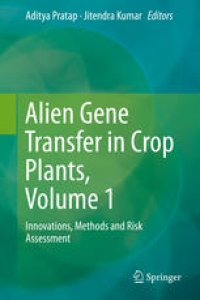
Ebook: Alien Gene Transfer in Crop Plants, Volume 1: Innovations, Methods and Risk Assessment
- Tags: Plant Sciences, Plant Breeding/Biotechnology, Plant Genetics & Genomics, Plant Anatomy/Development
- Year: 2014
- Publisher: Springer-Verlag New York
- Edition: 1
- Language: English
- pdf
Genetic engineering and biotechnology along with conventional breeding have played an important role in developing superior cultivars by transferring economically important traits from distant, wild and even unrelated species to the cultivated varieties which otherwise could not have been possible with conventional breeding. There is a vast amount of literature pertaining to the genetic improvement of crops over last few decades. However, the wonderful results achieved by crop scientists in food legumes’ research and development over the years are scattered in different journals of the World. The two volumes in the series ‘Alien Gene Transfer in Crop Plants’ address this issue and offer a comprehensive reference on the developments made in major food crops of the world. These volumes aim at bringing the contributions from globally renowned scientists at one platform in a reader-friendly manner. The 1st volume entitled, ‘Alien Gene Transfer in Crop Plants: Innovations, Methods and Risk Assessment” will deal exclusively with the process and methodology. The contents of this volume have been designed to appraise the readers with all the theoretical and practical aspects of wide hybridization and gene transfer like processes and methods of gene transfer, role of biotechnology with special reference to embryo rescue, genetic transformation, protoplast fusion and molecular marker technology, problems such as cross incompatibility and barriers to distant hybridization and solutions to overcome them. Since wild and weedy relatives of crop plants may have negative traits associated with them, there are always possibilities of linkage drag while transferring alien alleles. Therefore, problems and limitations of alien gene transfer from these species will also be discussed in this series. Further, the associated risks with this and assessment of risks will also be given due weightage.
Transfer of alien genes into crop plants from wild and distant plant genetic resources has invoked tremendous interest of crop scientists globally and several traits including resistance to diseases and insect-pests, tolerance to drought, salinity, temperature extremities and other abiotic stresses as well as genes for several quality traits have been transferred through vertical and horizontal gene transfer. Alien gene transfer, lately aided by molecular markers, molecular cytogenetics, genetic transformation and improved in vitro techniques has led to introgression of hundreds of genes of interest in crop species, thereby widening their genetic base and improving their genetic potential. While the gains through alien transfer are tremendous, these have also raised some doubts about the long-term economic and ecological impacts of such transfers in cultivated background. This book addresses all these issues and provides an insight into the methods, newer innovations, detection and achievements of alien gene transfer in crop plants. At the same time it also focuses on the issues of possible human and ecological impacts of alien gene transfers and describes the challenges and risks involved.